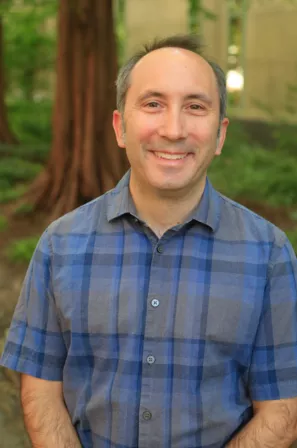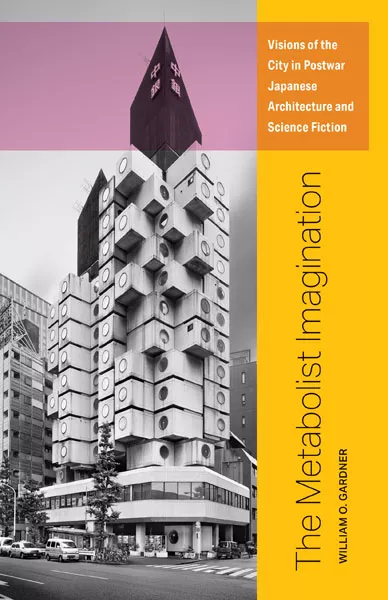Professor William Gardner Analyzes Postwar Japan Through Architecture and Science Fiction

In his new book, The Metabolist Imagination: Visions of the City in Postwar Japanese Architecture and Science Fiction, Professor and Section Head of Japanese William Gardner explores the Metabolism movement, which along with science fiction writers foresaw the global cities that would emerge in the postwar era.
Fueling this inquiry is Gardner’s insightful perspective: approaching architecture as a form of speculative fiction and science fiction as an intervention into urban design.
“In imagining a new building or urban design, architects envision a change in the lived environment that will have consequences over time,” he says. “The Metabolist group of architects that I discuss in the book, in particular, posited that the architect’s job was not to envision a single finished building or urban plan but to imagine the organic process of change over time.”
Gardner argues that this temporal element opens architecture to a narrative dimension, “which could encompass traditional storytelling as well as the new possibilities of computer simulation. Conversely, fiction writers and filmmakers may be able to capture dynamic aspects of the urban environment that static architectural tools such as plans or scale models cannot.”
The book, which Gardner started 12 years ago while on sabbatical in Japan, was released in April to glowing reviews.
“A must-read for anyone interested in urban studies, architecture, and science fiction — or, quite simply, the future,” wrote Ursula K. Heise, author of Imagining Extinction: The Cultural Meanings of Endangered Species.
Here, Gardner explains his passion for these studies and the new dimensions they gained in light of recent events.

What brought you to this subject?
My previous research was on Japanese modernist literature of the 1920s and 1930s, and how it related to the rapid cultural and social changes of that era. For my next project, I was interested in turning to the postwar era and examining some of the same relationships between new types of literature and changes in society, culture, and media. I began to research the emergent genre of science fiction as a ground for writers engaging with social and cultural transformation and imagining the future evolution of Japanese society.
I looked at the 1970 Japan World Exposition in Osaka, which was the first World’s Fair held in an Asian nation, and widely promoted as a model of the “city of the future.” I found that a number of science fiction writers were actually intimately involved in the production of this event, and that they had collaborated with the architects and designers who created the physical environment of the expo. This led me to an interest in architects as storytellers, and to discover unexpected commonalities between the methods and thematic interests of postwar architects and science fiction authors.
Were there any surprises along the way?
One theme that emerged was the importance of scale. The architects I was studying who were associated with the Metabolist architectural movement were exploring connections between structures of various scales, from the molecular, to the scale of a dwelling, to that of cities, to a planetary and even galactic or cosmic scale. And science fiction, especially through disaster narratives, was also exploring hidden connections between various scales, particularly connections and disconnections between the personal, the local, and the global or planetary.
Can you offer an example?
Some of the science fiction narratives I studied imagined the disappearance of the entire city of Tokyo, or the submergence of the entire Japanese archipelago in a giant seismic event. In light of recent events, I’ve been newly struck by the prescience and relevance of these disaster narratives, some of which were imagining the effects of human-caused climate change as early as the 1960s, or which posited a narrative of global pandemic in 1964, ahead of such well-known American narratives as Michael Crichton’s The Andromeda Strain from 1969 or Stephen King’s The Stand from 1978.
What are the key messages you hope readers take from the book?
There is a tension in the works of both architects and writers I discuss in my book between utopianism — the power to imagine visionary solutions to collective problems — and the imagination of disaster, or the idea that ruins are the ground from which our cities and societies emerge and to which they will return. I feel that this a productive tension for us all to examine as we ponder our lives in the 21st century. For example, in my analysis of the novel Virus: The Day of Resurrection by Komatsu Sakyō, I discuss how the novel not only highlights global interconnectivity, but also demonstrates how fragile our global interconnections actually are, as the true threat of the deadly virus in the story eludes mankind due to a collective lack of imagination, parochial rivalries, and politically or nationalistically inspired information monopolies. Conversely, the heroes in this author’s work are figures who are able to discern underlying patterns invisible to others, who fight for information transparency, and who can imagine scales of potential catastrophe beyond the scope of conventional assumptions.
For more, listen to Gardner on the How Do You Like It So Far podcast, or read a chapter excerpt in the online journal Places.



